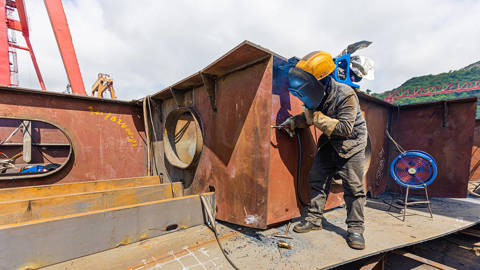No Time to Waste
Saving the planet from catastrophic climate change will require not only a dramatic increase in funding for clean-energy research and development. We need innovation in policy just as much as in technology.
This month Bill Gates published his new book, How to Avoid a Climate Disaster: The Solutions We Have and the Breakthroughs We Need.
Connie Hedegaard: Let me start with a confession: For years, I thought you were not particularly interested in climate change. I vividly recall a closed session at Davos some years back. The discussion turned to climate, instead of other sustainability issues, and you left the room.
Now you powerfully and emphatically make the case for urgent climate action. You start your book by describing this journey. At first, it was “hard to accept that as long as humans kept emitting any amount of greenhouse gases, temperatures would keep going up.” It was only after returning to a group of climate scientists “several times with follow-up questions” that it eventually “sank in.” To what do you attribute your initial resistance, and how might your experience be applied to getting others on board?
Bill Gates: The world is in a very different place today than when I started studying climate change. We know more and have established more of a consensus about the problem. But it’s still hard for many people to accept that only reducing emissions, without getting on a path to zero, isn’t enough. It’s also hard to accept how much innovation it will take to get to zero – to fundamentally remake the energy industry, the largest business in the world. In the book, I make the case that persuaded me, and I hope it persuades others. I’d urge climate advocates to keep making the case for zero and for reducing emissions in a way that puts us on that path.
CH: From your bathtub analogy to your fish allegory, you dedicate significant attention to making abstract concepts or complex data more concrete and accessible. Do you think this approach is the key to finally shifting the mindset of those who, despite all the science and data, still seem to believe that we can just continue with business as usual? Have similar approaches helped you in your work pushing the technological frontier at Microsoft or advancing global health and development at the Gates Foundation?
BG: Although the book isn’t aimed specifically at climate-change skeptics, I certainly hope it will persuade them that we need to invest seriously in clean energy. The countries that do the most to nurture innovation in this field will be home to the next generation of breakthrough companies – along with all the jobs and economic activity that accompany them. That’s why these investments are the smart thing to do, even if you don’t buy the ironclad case that humans are causing changes in the climate that will have catastrophic consequences if left unchecked.
CH: The COVID-19 pandemic not only highlighted the costs of ignoring science, but also proved that rapid, large-scale behavioral change is possible, and showed that leaders who take responsibility for addressing problems can gain respect. But, as you point out, it also carried another crucial lesson: the relatively small (10%) reduction in greenhouse-gas emissions that global lockdowns produced showed that behavioral changes like flying or driving less are nowhere near enough. Are there other lessons we learned during the pandemic that apply to climate change? How can we best apply them to climate action?
BG: One lesson is the flip side of the idea that flying or driving less isn’t enough: We need a massive amount of innovation so that people can fly, drive, and otherwise participate in the modern economy without causing emissions. This is actually an even tougher challenge than making and distributing COVID-19 vaccines (which is the biggest public health campaign ever).
But it will take the same close cooperation among governments at all levels, and with the private sector as well. And just as we all have to do our parts by wearing masks and distancing, individuals also need to play a role in reducing emissions. They can advocate for policies that accelerate the transition to zero, and they can reduce the Green Premium by buying low- and zero-carbon products like electric cars and plant-based burgers. That will attract more competition in those areas and ultimately make it cheaper to go green.
CH: Like ending the pandemic, you argue, addressing climate change hinges largely on science and innovation. Overall, you are “optimistic that we can invent [the tools we need], deploy them, and, if we act fast enough, avoid a climate catastrophe.” What experiences or lessons instilled this belief in you?
BG: I’ve seen first-hand how investments in R&D can change the world. Research sponsored by the US government and American companies made microprocessors and the Internet possible, which unleashed a phenomenal amount of entrepreneurial energy to create the personal computer industry. Likewise, the US government’s effort to map the human genome led to breakthroughs in the treatment of cancer and other deadly diseases.

SUMMER SALE: Save 40% on all new Digital or Digital Plus subscriptions
Subscribe now to gain greater access to Project Syndicate – including every commentary and our entire On Point suite of subscriber-exclusive content – starting at just $49.99
As for getting to zero, I’m seeing amazing work myself. Breakthrough Energy Ventures, the private fund I built with a number of partners, has invested in more than two dozen companies that are working on low- and zero-carbon ways to make cement and steel, generate and store large amounts of clean electricity, grow plants and animals, transport people and goods around the world, and heat and cool our buildings. Many of these ideas won’t pan out. But the ones that do could change the world.
CH: As you note, however, “innovation is not just a matter of developing new devices. It’s also a matter of developing new policies so we can demonstrate and deploy those inventions in the market as fast as possible.” The European Union (and now also China) has started to engage in such policy innovation.
In an effort to correct a flawed incentive structure that fails to take into account what you call “Green Premiums,” many European countries have introduced mechanisms for taxing CO2 emissions, resource waste, and pollution. Are such policies shifting the incentive structure in a meaningful way? Would a carbon border-adjustment mechanism help to drive progress?
BG: Putting a price on carbon is one policy that will make a difference, as part of an overall approach where the goal is to increase both the supply of and the demand for clean-energy breakthroughs. I mention a wide range of other ideas in the book. For example, one thing governments can do to expand the supply of innovation is to expand funding for clean-energy R&D dramatically. (I recommend a five-fold increase.) On the demand side, in addition to a carbon price, it is things like standards for how much electricity or fuel must come from zero-carbon sources.
We need innovation in policy just as much as in technology. We have seen policy and technology come together to solve big problems before. As I document in the book, air pollution is a great example; the US Clean Air Act did a very good job of getting poisonous gases out of the air. Other incredibly effective policy solutions in the US include rural electrification, expanding energy security, and sparking economic recovery after the Great Recession of 2008. Now we need to turn the world’s policy and technology IQ to eliminating emissions. My team at Breakthrough Energy, the network of initiatives I founded to accelerate the clean energy transition, is working hard to develop and advocate for bold policies that achieve the world’s climate goals.
CH: Governments, you point out, have often attempted to use rules adopted to solve other problems to reduce emissions – an approach akin to trying to “create artificial intelligence using a 1960s mainframe computer.”
But introducing major new legislation is difficult, not least because the incumbent producers resist higher standards and other costly changes. As someone who has been on the “regulated” side of the regulatory equation, what solutions or insights do you see for resolving the problem of lagging policies?
BG: We need government action to solve this problem – we are talking about transitioning the world’s entire energy system at an unprecedented speed. Private-sector investments alone won’t be successful unless we have the market conditions that reward innovation and allow clean technologies to compete, and we need government to help create that environment. So, we need government action, and it needs to be targeted, robust, and predictable.
This is also why I talk about innovation not just in technology, but in policy and markets too. We need policymakers to think creatively about the right ways to spur clean energy innovation, level the playing field, and accelerate the energy transition. My team at Breakthrough Energy is working with leaders across government to develop and advocate for the policies we need to get to net-zero emissions.
CH: Beyond policy, you suggest that governments must be bolder when investing in climate-related research and development. What role should universities play here, both in terms of research and transmitting the knowledge needed to shape policies?
BG: Universities provide an environment that fosters ideas and they develop clean technologies. The science, research, and engineering at the world’s universities are among the most important factors in helping us achieve net-zero emissions. Of course, discoveries need to move out of the university setting, to inform new policies and shape the marketplace. Some academic institutions are making concerted efforts to help their professors communicate more effectively, make their research more relevant to policymakers, and propel their technological discoveries into companies and markets. These pieces are crucial to avoid a climate disaster.
CH: You emphasize that the moral case for climate action is just as strong as the economic case, because climate change disproportionately harms the world’s poorest. But climate action also has distributional implications. As you acknowledge, even the very low Green Premium for decarbonizing America’s entire electricity system might not be affordable for low-income households, and developing countries are in a far weaker position to bring about such a transformation at all. How can these challenges be overcome? Does your work deploying other technologies in lower-income settings hold relevant lessons?
BG: This is a hugely important topic. Low- and middle-income countries are going to be using more energy in the coming decades as they rise out of poverty. We should all want that energy to be clean – but they’ll only commit to using clean energy if it’s as cheap as fossil fuels are today.
So, if you’re a leader in a rich country, you should be asking yourself what your government or company is doing to make it affordable for the entire world – including middle-income and eventually low-income countries – to go green. The expanded investment in R&D and other policies need to be aimed at this goal. Many of the companies I’m investing in are working on ideas that would be affordable in lower-income countries.
CH: You are among a number of business leaders who now publicly recognize government’s critical role in any massive undertaking. Even among such undertakings, climate change stands out. Will meeting the challenge require a greater role for the public sector – in general or in a particular area – than even the most pro-government voices are used to?
BG: The transition to clean energy will have to be driven by both governments and the private sector working together – just as the personal computer revolution was.
It will mean a greater role for government, but only because that role has been relatively small so far. Take the five-fold increase in public-sector R&D we discussed earlier. That increase would put clean-energy research on par with health research in the US. And just as we have the National Institutes of Health to oversee and coordinate that work, we should create the National Institutes of Energy Innovation (NIEI) to avoid duplication and make the best use of these resources. An Institute of Transportation Decarbonization would be responsible for work on low-carbon fuels. Other institutes would have similar responsibilities and authority for research on energy storage, renewables, and so on.
The NIEI would also be responsible for coordinating with the private sector. The goal would be to have research coming out of national labs that leads to breakthrough products that get to market at a very large scale. We need policies that speed up the entire innovation pipeline, from early research to mass deployment.
CH: At one point in the book, you write that, “Beyond finding ways to make materials with zero emissions, we can simply use less stuff.” Some would argue that capitalism depends on consumption – the more, the better. Does a true solution to the climate crisis depend on a new vision of capitalism for the twenty-first century? Could, say, a new, more qualitative understanding of “growth” form the foundation of such a system?
BG: I do think people in the rich world can and should cut back some on their emissions. (As I mention in the book, I’m taking a number of steps to reduce and offset my own emissions.) But energy use is going to double worldwide by 2050, driven by significant growth in low- and middle-income countries. That growth is good in the sense that it means people are living healthier, more productive lives. But we need to do it in a way that doesn’t make the climate problem harder to solve. That’s why we need innovation that makes it cheap enough for everyone around the world to eliminate emissions.
CH: You write that your “book is about what it will take to [avoid a climate catastrophe] and why I think we can do it.” Hand on heart: Do you believe we will get our act together in time?
BG: Yes. As I write at the end of the book, I’m fundamentally an optimist because I’ve seen what technology can do, and I’ve seen what people can do. What we need to do is spend the next decade getting the right policy, technology, and market structures in place so most of the world can be at zero emissions by 2050. We don’t have any time to waste.




